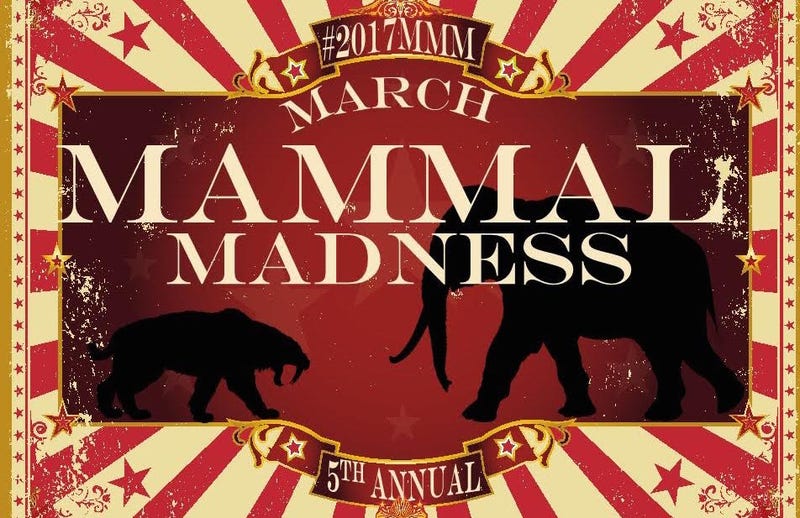To
observe a science communicator, I observed March Mammal Madness, which is a
public engagement project started by Katie Hinde. Since its inception in 2013,
March Mammal Madness has grown into an international event with a large team of
scientists sharing the planning and execution of this month-long outreach
endeavor. The concept is modeled on an NCAA tournament, with different animals
competing against each other in a bracket. Data on each animal’s size, habitat,
and fighting abilities are used to generate probabilities of each winning, and
randomness is introduced in selecting the winner of each outcome. Higher-seded
animals get the advantage of competing within their own habitat in the first
rounds, and in the final rounds, habitat is chosen at random. The scientific
team then develop a narrative surrounding the battle that incorporates facts
gleaned from peer-reviewed sources, and then live-tweet the narrative of each
battle. After each set of battles, the tweets are documented via Storify and
posted on Hinde’s blog and the March Mammal Madness Facebook page.
 |
| My 2013 Bracket--I think this was my first selfie EVER! |
I originally participated in the first March
Mammal Madness in 2013. Back then, it was on a smaller scale, and it seemed
that it was just for a bunch of animal biology nerds to have some fun with
March Madness. Since then it has grown exponentially, and some educators now
build classroom curricula to coincide with March Mammal Madness. This year, the
organizers made the bracket selection available to educators early to plan
curricula, and over 200 educators took advantage of this. The scientific
planning team has now expanded to include eight scientists narrating the
battles. Additionally, a scientific illustrator creates accompanying artwork,
two additional scientists tweet facts about the individual species, and the
American Society of Mammalogists and Cleveland Museum of Natural History tweet
facts and images. This year, #2017MMM began with additional fanfare, including
an outreach event at Arizona State University and a green-screened theatrical version
of the wild card battle. Additionally, fans have created their own blog or
video recaps.
I’ve
followed along March Mammal Madness every year, but my interest often wanes.
Each year, I start out following enthusiastically, but lose interest as my favorites
become eliminated. This year, I intended to follow the entire tournament. I was
especially invested in this years’ battles, as my favorite animal and study
species, Geoffroy’s spider monkey, was a competitor. One of the great strengths
of March Mammal Madness is that it’s easily adaptable to needs of different
educators and interest groups. In the past, my participation was for fun.
However, I have colleagues that used it in teaching undergraduates and high
school students. For some, it was a fun teaching opportunity that they could
incorporate for extra credit. For others, they could build a curriculum around
it. Many scientists and educational organizations now use it as an opportunity
to share facts about their study species. This year, in addition to
incorporating it as one of our lab’s social activities, I wrote a blog post
about the spider monkey’s shot at the championship and took advantage of the
spider monkey battle days to tweet pictures and fun factoids about spider
monkeys. And, since many scientists enjoy trash-talking the competition, I took
advantage to share pictures, facts, and some trash-talk about a fellow primate
competitor, the white-headed (or white-faced) capuchin monkey.
 |
| Capuchins are cute, but seriously, they are little punks! |
The drawback of March Mammal
Madness, however, is that it’s so drawn out, and keeping up with the
live-tweets is time-consuming. The first week, each battle day took about three
hours to live-tweet—for a total of approximately nine hours a week. Despite my
best intentions, I didn’t have the time or energy to spend following the
live-action, so I ended up focusing on tweeting and following the action on
days when the spider monkeys competed, and caught up the next day with recaps
and Storify. However, while they were useful summaries of who won/lost, reading
through the Storify can be tedious, and I imagine for those that aren’t
familiar with twitter, it may be hard to follow.
While the spider monkeys made it to
the final four, they were beaten by the honey badger, and as usual, my interest
waned once my favorite was eliminated. While, March Mammal Madness is fun, and
a great opportunity for educators to introduce mammalian biology and behavior,
I think it’s hard to track over the course of the month unless you are very
invested. In our own lab group, I did my best to provide updates, but by the
end, none of our lab’s undergraduates kept up and tabulated their brackets.
Nonetheless, I think it’s a great resource for elementary school teachers, who
can take advantage of the early brackets and associated information to build
their own lesson plans around the mammalian competitors. This year, it received a large amount of media attention, including articles in Gizmodo, NPR,
and other outlets, and the media interest indicate it’s become an incredibly
successful outreach effort. The lessons I’ve learned from March Mammal Madness
are that 1) public engagement can and should be fun, and 2) building a
recurring, large-scale public engagement project requires a lot of initial
investment, but requires a larger team to be sustainable.
